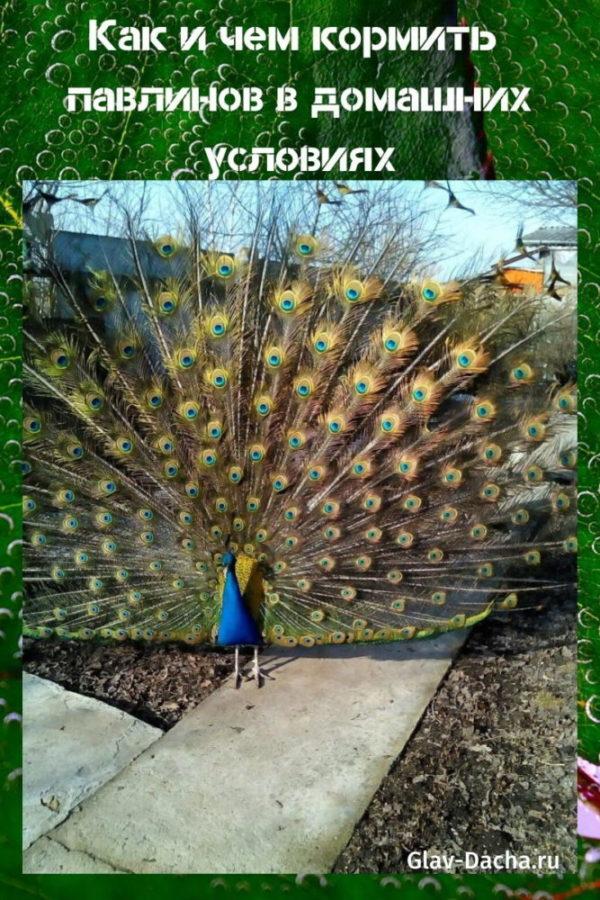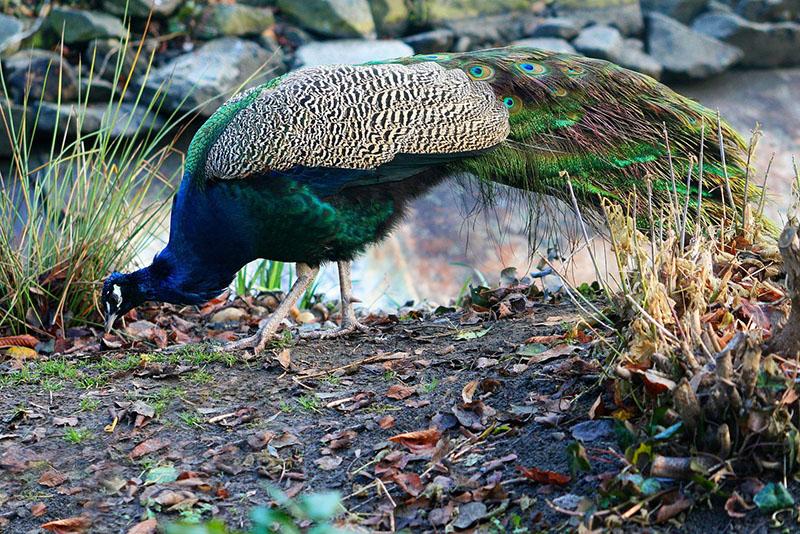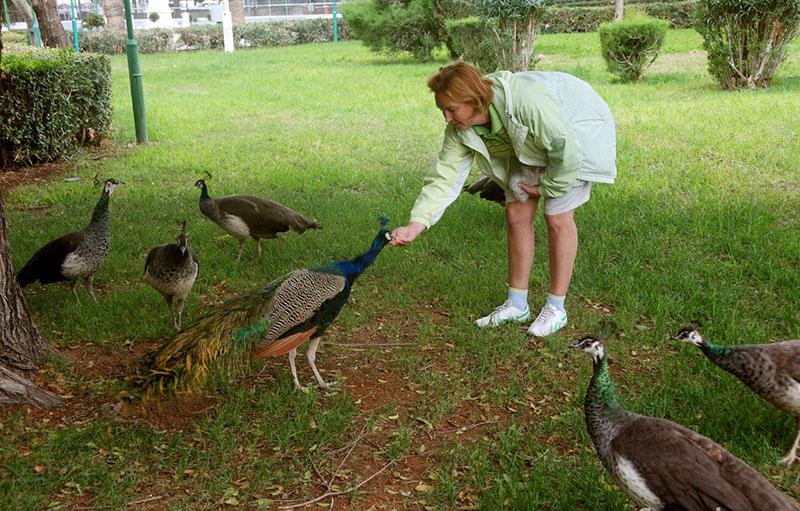How and what to feed peacocks at home
 Peacocks, representatives of the hot tropics, can be grown in the northern regions. But how to feed peacocks at home, if you cannot completely provide them with natural, familiar food? Hobbyists who keep birds in aviaries often try to create a suitable breeding environment for them. They include in their diet the fruits and seeds of not only cultivated, but also wild plants, berries, human food.
Peacocks, representatives of the hot tropics, can be grown in the northern regions. But how to feed peacocks at home, if you cannot completely provide them with natural, familiar food? Hobbyists who keep birds in aviaries often try to create a suitable breeding environment for them. They include in their diet the fruits and seeds of not only cultivated, but also wild plants, berries, human food.
What peacocks eat in nature: some behavioral features

Birds delight in digging in the ground, hoping to get themselves tasty larvae and worms for lunch. And their family relations are no different. One male, as a rule, has several females - pea, whom he jealously guards.
Peacocks live in forests, especially where there are many shrubs. They can be found in Bangladesh, Nepal, Pakistan. And in India they have been considered a national symbol since 1963. The birds are very careful, at the slightest danger they emit sharp cries and fly up the trees. However, this does not mean that they are shy. Rather, the opposite is true. Indeed, in addition to plant food, they gladly eat various animals - insects, small reptiles, molluscs. They even attack small cobras.
How to feed peacocks at home at different periods of life
 The nutrition of these large birds must be balanced and complete, otherwise non-compliance with the rules of feeding can provoke metabolic disorders and a number of diseases.
The nutrition of these large birds must be balanced and complete, otherwise non-compliance with the rules of feeding can provoke metabolic disorders and a number of diseases.
Peacocks' food should contain the optimal amount of vitamins and minerals for these birds. In addition, it is necessary that it is fresh, and they eat it with pleasure.
The taste of the food is very important for peacocks. Despite the fact that they are considered omnivores, if they do not like the food, they will refuse the proposed lunch. It is also very difficult to accustom birds to a different diet. It is easier for them to die of hunger than to swallow even a grain or a particle of the mixture that they saw for the first time. Therefore, new food is added to their usual food gradually, and its volume is increased every day.
It is impossible to abruptly transfer peacocks to another food. This negatively affects the digestion of adult birds. But this process is especially difficult for young individuals and chicks.
Feeding adult birds
 Peacocks feed in the same way as chickens or turkeys. Their diet is based on grains and vegetables. I like fruits, crackers, freshly cut grass. They will be happy to eat a piece of bacon, a portion of minced meat or fish allocated for them.
Peacocks feed in the same way as chickens or turkeys. Their diet is based on grains and vegetables. I like fruits, crackers, freshly cut grass. They will be happy to eat a piece of bacon, a portion of minced meat or fish allocated for them.
The daily diet of birds can consist of fresh grass or hay, but with the obligatory supplements per bird:
- 50-60 g of crushed corn kernels;
- 90-100 g of grain waste;
- 40 g oats or barley;
- 50 g of alfalfa flour, vegetables and root crops;
- about 10 g of sunflower cake.

When peacocks feed on one grain, mineral supplements are required. They are laid out in special feeders:
- ground salt mixed with slaked lime or chalk;
- small gravel, coals and ash left over from burnt birch firewood.
The presence of wood ash and fine gravel in the bird walking area is mandatory at any time of the year.
Feeding during the breeding season
 Peacocks reproduce most effectively in enclosures, since it is there that they feel relatively free, because the conditions of detention resemble the natural environment. They can independently get food - eat a worm or an insect, feast on young and juicy grass. Dexterous birds are able to catch flies and mosquitoes on the fly.
Peacocks reproduce most effectively in enclosures, since it is there that they feel relatively free, because the conditions of detention resemble the natural environment. They can independently get food - eat a worm or an insect, feast on young and juicy grass. Dexterous birds are able to catch flies and mosquitoes on the fly.
In March, peacocks begin to prepare for egg-laying. During this period, frequent feeding is required, it is necessary to increase the proportion of soft feed and animal origin. Minced meat is given twice a week.
The rest of the feed daily (in terms of 1 head):
- chopped boiled potatoes - up to 100 g;
- herbal flour - up to 50 g;
- 10 g meat flour;
- protein feed (dry) - up to 200 g.
Enhanced nutrition will maintain good health in adults and will have a beneficial effect on the viability of future chicks. Soft foods are better absorbed in the morning. Compound feed and cereal mixtures are fed in the afternoon.
Features of feeding chicks
 Newly hatched chicks are offered a hard-boiled, finely chopped chicken egg, to which chopped greens must be added. On the second day, flour worms are added to their food. And a week later, millet porridge, compound feed intended for chickens or pheasants is introduced into the diet. Drink water, yogurt.
Newly hatched chicks are offered a hard-boiled, finely chopped chicken egg, to which chopped greens must be added. On the second day, flour worms are added to their food. And a week later, millet porridge, compound feed intended for chickens or pheasants is introduced into the diet. Drink water, yogurt.
The grown-up chicks enjoy drinking milk, eating cottage cheese, eating finely chopped root vegetables and vegetables, they really like minced meat.
Fresh greens are cut into them as needed. Sometimes several times a day. These can be young shoots of nettles, spinach leaves, green onion feathers, juicy clover. All these "vitamin supplements" are not introduced immediately, but gradually. Make sure that they are eaten by chicks.
Types of food for peacocks

Experts have developed several methods that give, in general terms, the most complete idea of what peacocks are fed at home:
- Wet. In addition to juicy roots and vegetables, minced meat, green grass, the birds are given plenty of compound feed steamed in hot water. However, it must be borne in mind that during the warm period, the feed must be eaten completely, since the remaining one can sour very quickly. If there are residues, they are immediately removed, and the feeders are washed.
- Dry. All feeds are fed to peacocks only in dry form, for example, compound feed and grain mixtures. In this case, the birds should always have unhindered access to feeders with mineral supplements, usually chalk and coal, as well as special vitamin complexes.
- Combined. One of the best types of feeding, the most balanced. Grain and dry compound feed are poured abundantly into the feeders. And birds are fed with wet mash in the morning and in the evening.
In winter, the amount of food for each bird should be increased by 50%.
Complementary feed
 Compound feeds and cereals are not all that peacocks eat. Worms are an important addition. When breeding birds, they must be specially grown in silo pits. The need per day for one individual is about 10 g.
Compound feeds and cereals are not all that peacocks eat. Worms are an important addition. When breeding birds, they must be specially grown in silo pits. The need per day for one individual is about 10 g.
Meal worms are also bred, the larvae of a black beetle, which is called a flour beetle. Just like worms, they can be grown in a worm-breeder - a tightly closed wooden box without cracks, filled with old breadcrumbs, spoiled flour, scraps of various root vegetables and vegetables. After the "launch" of this design, the larvae appear in 1.5–2 months.
Worms and larvae are an important protein source for peacocks. But other supplements are also needed. Here's what peacocks eat from juicy feed:
- leaves and young shoots of quinoa;
- needles;
- milk, cottage cheese and yogurt;
- fish fat;
- peas;
- dandelions;
- clover and alfalfa.
Of the root crops, potatoes are considered the most valuable for birds. It is added boiled to the mash and, in the event of the appearance of weakened individuals, fed to them in pure form. Here's another thing to feed peacocks at home. Both chicks and adult peacocks eat cabbage and carrots.You can finely chop beets, turnips, turnips. Oats can be replaced with barley.